Fractal Design Arc Midi R2 Review: Improving On A Classic Case
Fractal Design scored a lot of fans with the simple and elegant architecture of its Arc Midi enclosure. The Arc Midi R2 represents an evolutionary step forward for the company, incorporating a number of refinements that build on the original's strengths.
Air Cooling, Dusty Protection, And Liquid Cooling
Air Cooling and Dust Protection

Despite all of the fans and mesh, the Arc Midi R2 effectively keeps dirt out. All of the largest openings are covered by generously-sized dust filters that are easy to access for cleaning. The front filter snaps into place on the top left and right, and can be pulled back off by pressing both spots simultaneously. Doing so exposes Fractal Design's FD-FAN-SSR2-140 140 mm fan. The same type of fan is used throughout the case, guaranteeing a homogenous rotational speed and noise level. Only the top cut-out is filled; the bottom is ready to accept another fan if you need it.
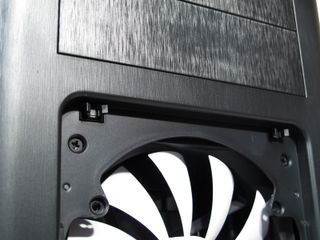
The bottom dust filter protects the power supply and another (optional) fan on the case's bottom. It's easy enough to pull out the back. Thick and high case feet leave plenty of room under the Arc Midi R2 to pull in air. They sport a nice chrome look, also help decouple the case from the surface on which it stands using soft rubber pads.


A third filter is attached to the Arc Midi R2’s top cover. Taking it out is more of a hassle because you need to free up to thumb screws on the back. Then again, it's also easy enough to clean with a vacuum cleaner from up top. This is possible because the 140 mm fan under the cover exhausts hot air out of the case, which means that the filter is only there to keep dust particles from falling in from above.
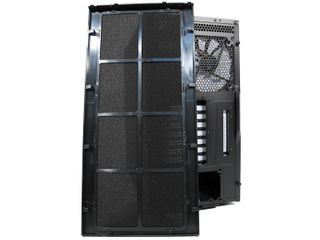
If you want a little more airflow, there's room to install as many as two more 120 or 140 mm fans under the top cover.
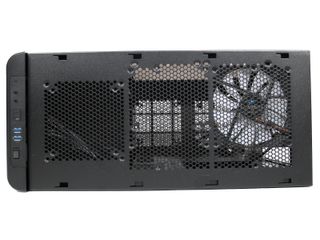
Fractal Design's Arc Midi R2 comes with a third fan installed from the factory. The basic configuration should be enough to adequately cool typical gaming systems with minimal noise. All three fans have three-pin connectors that are compatible with the integrated three-speed fan controller. The fan controller’s 12, 7, and 5 V result in approximately 1000, 700, and 500 RPM. It should be noted that the fans aren’t connected to the fan controller out of the box. You'll need to make those connections, and, in turn, hook the controller up to your power supply with a four-pin Molex connector.

Water Cooling
Larger radiators and compact water cooling solutions in a 240 mm format are giving air coolers a run for their money nowadays when it comes to cooling performance at a decent noise level. It’s nice that Fractal Design took this into account when the company redesigned its Arc Midi. The case doesn’t just feature the option to install those coolers on the inside of the top cover.
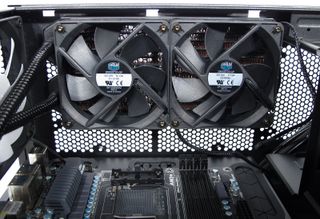
The Arc Midi R2 also features an additional place for liquid cooling radiators in the front, right behind the front cover. Removing the top hard drive cage from the case, and moving the bottom one to the bottom-middle, results in 140 mm of space for the radiator and fans. The installed 140 mm fan can even be taken out and replaced with up to two 120 mm blowers, enabling powerful push-pull configurations for the radiator.
Stay on the Cutting Edge
Join the experts who read Tom's Hardware for the inside track on enthusiast PC tech news — and have for over 25 years. We'll send breaking news and in-depth reviews of CPUs, GPUs, AI, maker hardware and more straight to your inbox.
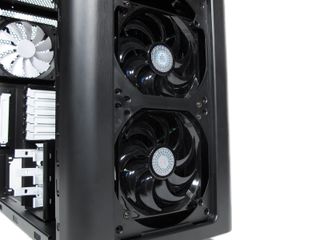
We did stumble upon one caveat, which can be addressed with a little do-it-yourself resourcefulness. The screw threads for the 120 and 140 mm fans are recessed fairly deeply to fit the case fans. If the screws that come with your specific radiator have heads that are too big to fit the recessed openings, and thus sit on top of the cover, then the screws might not be long enough to reach the radiator’s internal threads. This was the case with Cooler Master's Eisberg Prestige 240L.
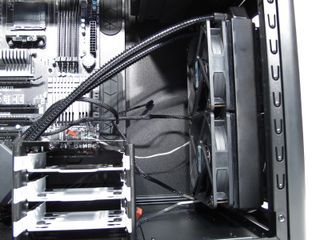
Our trick for getting the Cooler Master unit installed was using two of the Eisberg fans’ four long screws to attach the rear fans to the radiator, and then attaching the radiator and additional fans to the front cover with the other two. This worked because Cooler Master included a few extra millimeters of thread to account for a thick decoupling rubber pad that the screws normally go through. We wouldn't blame you for getting annoyed if you were mid-build and found yourself unable to secure your CPU cooler.
There’s ample space on all sides of a 240 mm radiator, which should eliminate compatibility problems stemming from its dimensions. Even if the tube connectors stand out far toward the top of the case, the rail for the upper 3.5” hard drive cage can be detached from the 5.25” drive cage above, which affords even more clearance. It’s only held by four screws.
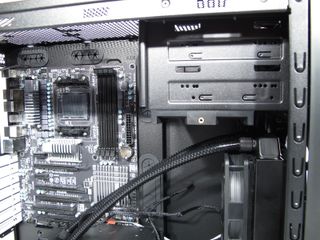
Current page: Air Cooling, Dusty Protection, And Liquid Cooling
Prev Page The Arc Midi R2's Exterior Next Page Power Supply Installation And Cable Management-
f-14 Solution: buy some rubber toilet grommets or faucet washers from your local hardware store price will range from 25 cents to a little under a dollar and the problem is solved.Reply
Some Notes and Recommendations about Replacing the Fans
Let's say everything else about the Arc Midi R2 is ideal for you, and you simply want to replace its fans. -
dish_moose I think a fan that vibrates when pointed down is an inferior product. I had to replace the fan on my Antec 302 for the same reason - drove me crazy. As for beauty over function - I would much rather keep my GPU cool that have a "pretty" side window.Reply
-Bruce -
mouse24 ^ Was it a sleeve bearing fan? If so thats more or less normal due to how that bearing is designed.Reply -
SchizoFrog Who puts a fan in the roof of a case to blow downwards? Surely the roof is best used as an exhaust and it was specifically mentioned about the fan blowing downwards. Personally I think I would be likely to buy a full set of fans so that I can fill all the fan mounts with the same design range and then keep the stock fans as emergency spares.Reply
As for keeping the GPU cool, I don't that is an issue with 2 the fans in the front creating perfectly adequate airflow to keep the GPU cool unless you are using multiple GPUs. Although in time I would probably mod the window and inserting an extra fan there as that isn't a hard job to do. -
cjny71 Regarding the change from a side panel with a mesh vent to a window, I am not sure if this would make much of a difference to GPU cooling. I have the original Fractal Midi and I wanted to isolate noise a bit more, so I swapped the side panels so that the vented one is on the back of the mother board side. I had also installed 1 extra 140 mm fan in the bottom of the case blowing up to draw in cool air underneath. I did this before swapping the side panels. All of my 140 mm fans are turning at 700 rpm. Surprisingly I noticed that in this configuration the GPU was slightly cooler (1-2 C) at idle and under load with the solid panel on the right / GPU side, and the noise seemed a little lower. CPU temps did not change. I would have to guess that the mesh hole provides an escape port for air and the GPU fan has to work harder.Reply
Heat Sources: i5-3570K @ 4.4 GHz, Hyper 212 EVO, EVGA GTX 560Ti @ 900 MHz, 3 WD Cavier Black HD -
RazberyBandit The Arc Midi 2 and Define R4 use an identical core case design. The only design differences are found in the front and top panels. (Both are mesh in the Arc Midi 2, while the Define R4 has a front door and sound-proof material fan opening covers for the top fan openings.)Reply
With Define R4's often available for roughly $85 (on sale) and Arc Midi 2's typically about $65 online, I find the $20 additional cost for the sound-proofing included in the Define R4 models a very worthwhile investment. -
InvalidError Reply
Does your GPU have its fan at one end of the card and exhaust directly outside through the rear bracket? If it does, the reason you see lower GPU temps is likely that the slightly more positive (or slightly less negative) pressure in the case from going solid makes the GPU's HSF a little more efficient at shoving warm air out of the case. Cards with "mid-mount" fans may also benefit from this due to slightly increased vertical airflow between the GPU's top edge and case panel carrying warm air up through the case faster.11627141 said:Surprisingly I noticed that in this configuration the GPU was slightly cooler (1-2 C) at idle and under load with the solid panel on the right / GPU side, and the noise seemed a little lower.
That is what I like to call structured airflow. Placing fans in the most effective places and shutting off meshed areas that allow air to escape without contributing to net cooling can achieve superior results with much less meshed area and fewer fans. -
basketcase87 Reply11626775 said:I think a fan that vibrates when pointed down is an inferior product. I had to replace the fan on my Antec 302 for the same reason - drove me crazy. As for beauty over function - I would much rather keep my GPU cool that have a "pretty" side window.
-Bruce
Side fans don't always help GPU temps, they can even hurt temps in some cases by interfering with the airflow from the GPU fan. It really depends on the case and GPU (and whether or not the front intakes do anything for the GPU), but saying categorically that having an intake there will improve GPU temps is certainly not true. -
fat_panda It deserves a "Smart Buy" Award. Arc Midi R2 offers much more for the price than the competition while often being on sale for $65.Reply
Most Popular

